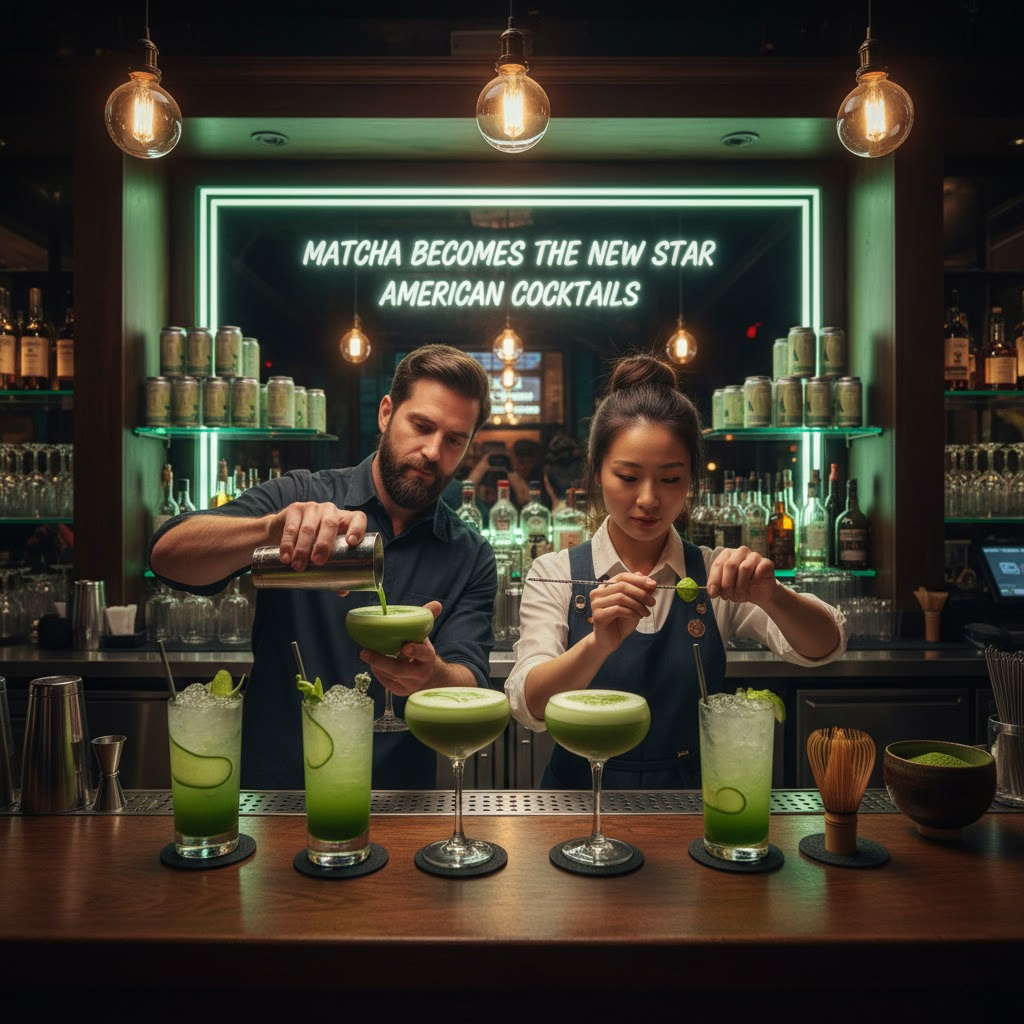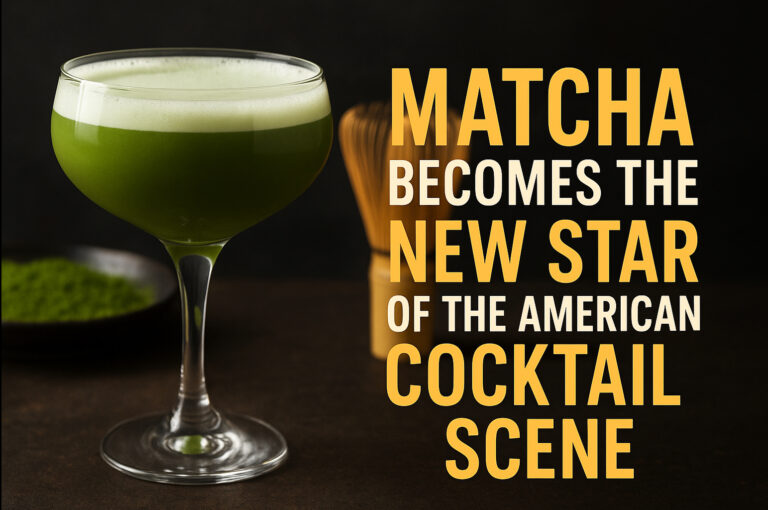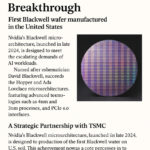Premium Biz Post – In a surprising twist in the world of mixology, a traditional Japanese ingredient has become the talk of America’s cocktail culture. Matcha Becomes the New Star of the American Cocktail Scene — a phrase now seen across beverage blogs, bar menus, and social media feeds — reflects how this bright green powdered tea is transforming both the flavor and aesthetic of modern drinks across the United States.

Once reserved for serene tea ceremonies, matcha has now made its way into the shakers and glassware of bartenders from Los Angeles to New York. Its earthy, slightly bitter taste and striking color have given mixologists an ingredient that is as photogenic as it is flavorful.
From Ceremonial Tea to Trendy Drink
The journey of matcha from the temples of Japan to the bustling bars of Manhattan is nothing short of remarkable. For centuries, matcha has been consumed in Japan as part of a meditative ritual — whisked with water and enjoyed in its purest form. But as global tastes evolved, Western consumers began to explore it as more than just a tea.
Matcha lattes and desserts were the first wave of the trend. Coffee shops began offering vibrant green drinks that captured both attention and Instagram likes. The second wave, which is now in full swing, has arrived in the form of cocktails. From Matcha Martinis to Matcha Mojitos, bartenders are discovering endless ways to blend this traditional ingredient with spirits like gin, vodka, and even sake.
“Matcha gives depth,” says Alex Rivera, head mixologist at Greenhouse Bar in Brooklyn. “It’s not just about color. It’s about balance — a mix of umami, bitterness, and sweetness that brings complexity to a drink.”
The Aesthetic Appeal: Green Is the New Gold
In the social media era, visuals matter almost as much as taste. Few ingredients can compete with the bright emerald hue of matcha when it comes to visual impact. Bars and cafés across the U.S. report that customers often order matcha-based cocktails simply because they look beautiful.
On TikTok, videos of bartenders pouring layers of matcha foam over milk-based cocktails have gone viral, with hashtags like #MatchaCocktail and #GreenMixology gaining millions of views. This aesthetic-driven demand has encouraged brands to experiment with pre-mixed or ready-to-drink (RTD) versions of matcha cocktails for convenience and consistency.
Even luxury bars are embracing the visual allure. At Las Vegas’s Wynn Hotel, the “Emerald Zen” — a combination of matcha, yuzu, and gin — has become one of their most-ordered signature drinks in 2025. Its vibrant green color has made it a social media darling, appearing in countless influencer posts.
Health and Functionality: Beyond the Buzz
Unlike many cocktail ingredients, matcha brings more than just flavor to the glass. It’s rich in antioxidants, particularly catechins, which are known for supporting metabolism and detoxification. Matcha also contains L-theanine, an amino acid that promotes relaxation without drowsiness.
This combination makes it an appealing addition for the growing “mindful drinking” movement — consumers who want to enjoy social drinking without overindulgence.
“People are increasingly conscious of what’s in their glass,” notes beverage consultant Erin Chang. “A cocktail that offers both enjoyment and health benefits feels like a win-win.”
This trend aligns with the broader rise of functional beverages in the U.S. market. Consumers are no longer satisfied with drinks that just taste good; they also want ingredients that serve a purpose. Matcha fits perfectly into that mindset, offering both aesthetic pleasure and tangible benefits.
RTD Matcha Cocktails: The Convenience Revolution
As the ready-to-drink (RTD) market continues to boom, matcha has found its place there too. Brands like Green Spirits Co., Shibuya Mix, and Zen Sip have launched canned matcha cocktails that appeal to both wellness-oriented millennials and adventurous Gen Z consumers.
These drinks, often blending matcha with sparkling water, fruit infusions, and light alcohol bases, are marketed as “refreshing alternatives” to sugar-heavy seltzers. They target people who want a sophisticated, low-calorie, and visually striking beverage option.
Market analysts predict that the RTD matcha cocktail segment could grow by 35% year-over-year in 2026, as distribution expands into major retail chains and e-commerce platforms.
“RTD drinks are the future of casual mixology,” says industry expert Daniel Holmes. “Matcha adds that premium perception — it’s healthy, it’s exotic, and it’s Instagram-worthy.”
Supply Challenges: The Tencha Shortage
However, the rise in demand has created supply-side challenges. Matcha production depends heavily on tencha, the shade-grown tea leaves used to make the powder. Climate shifts in Japan have affected yield consistency, driving up prices for premium-grade matcha.
Some beverage companies have turned to sourcing from newer producers in Taiwan, China, and even the U.S. Pacific Northwest. But purists argue that authentic Japanese matcha, especially from Uji or Nishio, offers unmatched quality and flavor depth.
The surge in global demand has also raised concerns about over-commercialization. “We must respect matcha’s cultural origins,” says Yuki Tanaka, a tea sommelier based in Kyoto. “It’s wonderful to see it gaining popularity abroad, but authenticity and sustainability should not be sacrificed for profit.”
Read More : ”DIY Aesthetic Pinterest Style Creative Ideas to Beautify Your Space”
The Bar Scene: East Meets West
Across the U.S., bars are reimagining matcha through a Western lens while honoring its heritage. Mixologists are pairing it with everything from mezcal and rum to yuzu and coconut water. The fusion of East and West is creating a new category of cocktails that are as experimental as they are elegant.
For example:
- The Matcha Mule – vodka, lime, ginger beer, and a hint of matcha syrup.
- Kyoto Sour – whiskey, lemon, egg white, and ceremonial-grade matcha dust.
- Zen Spritz – prosecco, matcha liqueur, and cucumber.
These drinks not only taste refreshing but also tell a story — one of cultural blending, creativity, and global connection.
Bars in major cities like Los Angeles, Chicago, and Austin are even hosting Matcha Mixology Nights, where patrons learn to whisk matcha and incorporate it into cocktails. Such experiences resonate with consumers who value both storytelling and participation.
Marketing and Branding: The Green Wave
From small craft distilleries to global beverage corporations, the “green wave” of matcha branding is hard to ignore. Companies are rebranding products around wellness, sustainability, and authenticity — three key drivers of consumer loyalty today.
Matcha-based beverages are often marketed using minimalist, eco-friendly packaging and messaging focused on mindfulness and balance. Brands are collaborating with Japanese artists to create elegant designs that blend modern minimalism with cultural motifs.
Moreover, the storytelling element — rooted in Japanese tradition and mindfulness — enhances the perceived value of each drink. Consumers aren’t just buying a beverage; they’re buying into a lifestyle that feels sophisticated, healthy, and culturally aware.
The Future of Matcha Mixology
So, what’s next for this green phenomenon? Experts predict that the matcha cocktail trend is far from a passing fad. As more consumers seek balanced indulgence — pleasure without guilt — matcha-based beverages will continue to evolve.
In the near future, expect to see:
- Non-alcoholic matcha elixirs for sober-curious consumers.
- Cold-brew matcha tonics combined with adaptogens.
- Dessert-inspired cocktails, merging matcha with chocolate, vanilla, or coconut.
- Global collaborations, bringing together Japanese tea artisans and Western mixologists.
As the market matures, innovation will depend on maintaining authenticity while pushing creative boundaries.
“Matcha’s versatility is its superpower,” concludes Rivera. “It can be elegant or playful, traditional or experimental. That’s why it’s not just a trend — it’s the beginning of a new chapter in cocktail culture.”
The rise of matcha in America’s cocktail scene represents more than just a passing fascination with all things green. It reflects deeper shifts in how people drink, what they value, and how they connect with global culture.
From artisanal bars to mass-market RTD cans, matcha’s journey is redefining the boundaries of mixology. It’s no longer just about alcohol — it’s about aesthetics, wellness, and experience.
Indeed, Matcha Becomes the New Star of the American Cocktail Scene not only in name but in spirit, symbolizing the perfect harmony between ancient tradition and modern innovation.



